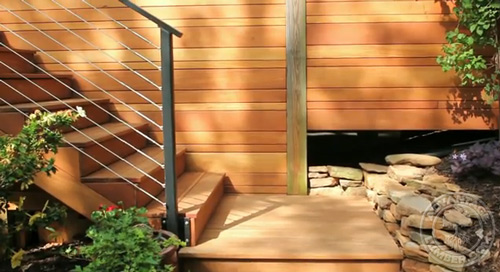Garapa – (Apuleia Leiocarpa)
Other common names include Brazilian Oak, Brazilian Ash, Cobre, and Garrote. The wood is medium density for a tropical hardwood and mills nicely. Using sharp cutters is important as It does have a dulling effect on cutter heads. Our factory sharpens tooling on site in order to provide excellent quality when milling such woods. Garapa is golden yellow in appearance and is available from our facilities as both FSC and Non-FSC certifications. Our Garapa is kiln-dried (KD) readily available as decking, flooring, dimensional lumber, E4E, S4S, RS (Rough Sawn), deck tiles, and table slabs.
Common Name: | Info coming soon |
Botanical Name: | Apuleia Leiocarpa |
Indigenous to: | The variety “molaris” is found in the Amazonian forest, mainly in flooded areas. The main species, Apuleia leiocarpa is found mainly in the South of Brazil, in the Atlantic coast forests, easily colonizing cleared areas. |
Modulus of Rupture: | 18,530 lbf/in2 (127.8 MPa) |
Shrinkage: | Radial: 4.2%, Tangential: 7.5%, Volumetric: 11.4%, T/R Ratio: 1.8 |
How is it dried: | kiln-dried (KD) |
Is it dried quickly: | No should be dried slowly |
Stability: | Moderately Stable to Stable |
Exterior Wood Recommendation: | Use class ensured by natural durability: class 2 – inside or under cover (dampness possible) Species covering the use class 5: Yes Against dry wood borer attacks:does not require any preservative treatment In case of risk of temporary humidification: requires appropriate preservative treatment In case of risk of permanent humidification: use not recommendedThe natural durability of Grapia is very variable. In some cases, this variability can be observed inside the same piece of wood. This species cannot be used without appropriate preservative treatment for end-uses under use class 3 except for some parts of a work such as windows, less exposed than
others (entrance doors, shutters).
This species naturally covers the use class 5 (end-uses in marine environment or in brackish water)
due to its high silica content. However, it is not recommended to use it in case of strong structural
constraints due to its medium mechanical properties; it is most suitable for end-uses like shipbuilding. |
Fastening Method: | Nailing / screwing: good but pre-drilling is necessary
Gluing: Yes |
Ecosystem impact: | This wood species is not listed in the CITES Appendices or on the IUCN Red List of Threatened Species. |
Toxicity and allergic reactions: | Although severe reactions are uncommon, Garapa has been reported to occasionally cause skin irritation. |
Odor: | Nothing discernable |
Products we manufacture using this species: | decking, flooring, dimensional lumber, E4E, S4S, RS (Rough Sawn), deck tiles, and table slabs |
Other common uses: | - Exterior joinery
- Light carpentry
- Heavy carpentry
- Hydraulic works (seawater)
- Ship building (ribs)
- Cooperage
- Turned goods
- Furniture or furniture components
- Wood frame house
- Flooring
- Industrial or heavy flooring
- Interior joinery
- Ship building
- Stairs (inside)
- Vehicle or container flooring
- Cabinetwork (high class furniture)
- Tool handles (resilient woods)
- Formwork
- Boxes and crates Wood-ware
- Note: Finishing is easy but filling is recommended.
|
Susceptibility to |
Dry Wood borers: | Durable – sapwood demarcated (risk limited to sapwood) |
Fungi: | Class 3 – moderately durable |
Termites: | Class M – moderately durable |
Treatability: | Class 3 – poorly permeable |
Janka Hardness: | |











